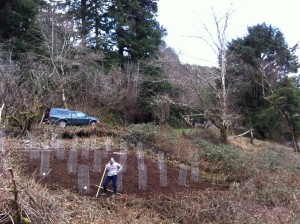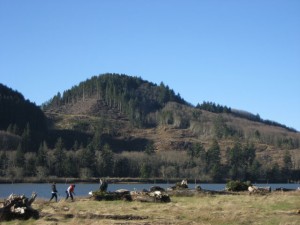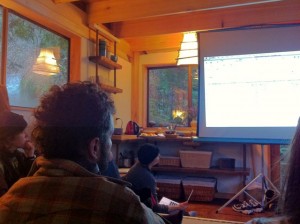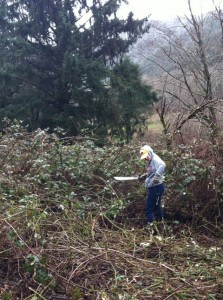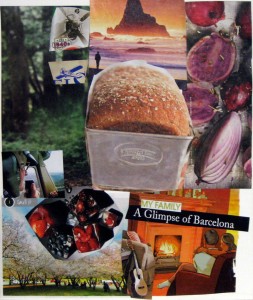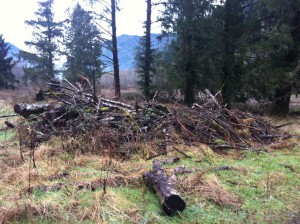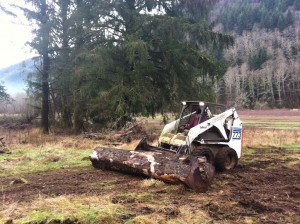Bees, of course! Emily and I are really interested in having bees on the farm, to better pollenate all the plants and to maybe even give us some honey. Last month we were introduced to Terry, the local beekeeping expert, and he took me with him to the local beekeepers’ meeting. It was an interesting group of about a dozen men and women, most of whom are twice my age, who keep from two to twenty hives apiece. We talked about some regional pathogens that can harm bees, gossiped about the neighbors, and planned for this spring’s shipment of bees. They pool their order, and when the bees are ready in April, a few of them drive to the valley to pick up the load. I IMMEDIATELY volunteered to go along… what excitement! A pickup winding through the mountains with several hundred thousand stinging insects in the back!
Of course, I don’t have any hives yet, but that didn’t dampen anyone’s enthusiasm for my participation. “Jim, you need a mentor,” Bob said in his slow and patient speech. He then looked at Terry, who it seems is held in esteem amongst them. Terry nodded and said he’d be happy to help me take care of my hives for the first year. Yes!
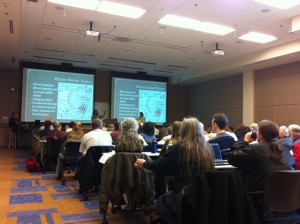 Up to this point, all I knew about bees is what I read in The Beekeeper’s Handbook, recommended to me as the best single definitive source on the art. (I guess this shows the power of books; I knew the answer to a few of the questions raised in the meeting before they were answered by the experts.) But that all changed last Saturday, when Emily and I attended Bee School, a one-day seminar hosted by the Lane County Beekeepers’ Association. My friend Andrew recommended it to me, and it was totally worth the tuition price and the three hour drive to get there. Lecture topics included equipment selection, hive management for our particular climate, pest management, and bee physiology. Some of the demonstrations were pretty hands-on, such as the session on constructing hive bodies and frames. It was super fun, and really gave a context to all I’d read beforehand.
Up to this point, all I knew about bees is what I read in The Beekeeper’s Handbook, recommended to me as the best single definitive source on the art. (I guess this shows the power of books; I knew the answer to a few of the questions raised in the meeting before they were answered by the experts.) But that all changed last Saturday, when Emily and I attended Bee School, a one-day seminar hosted by the Lane County Beekeepers’ Association. My friend Andrew recommended it to me, and it was totally worth the tuition price and the three hour drive to get there. Lecture topics included equipment selection, hive management for our particular climate, pest management, and bee physiology. Some of the demonstrations were pretty hands-on, such as the session on constructing hive bodies and frames. It was super fun, and really gave a context to all I’d read beforehand.
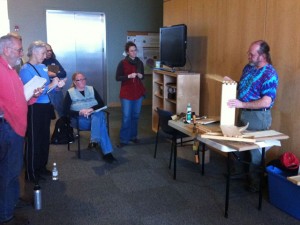 I then called Terry after Bee School to ask him to mark me down for one “nuc” (a unit of bees) when the local group makes their order. Looks like we’ll have bees next month! Now I have to get off my duff and buy/put together the hive boxes and frames I’ll need to house my bees when they arrive. All the beekeepers say that it’s best to start with two hives, not just one, so there’s a backup if something goes wrong with one of them. After some consideration, we decided that were going to start with just one regardless, for financial reasons. But if we have any luck at all, I can save up and buy additional hive parts in the next few months, and maybe catch a swarm. It’s all the rage with beekeepers (swarm = free bees), and I already told Terry that I want to go with him if he gets a swarm call from the fire department/police.
I then called Terry after Bee School to ask him to mark me down for one “nuc” (a unit of bees) when the local group makes their order. Looks like we’ll have bees next month! Now I have to get off my duff and buy/put together the hive boxes and frames I’ll need to house my bees when they arrive. All the beekeepers say that it’s best to start with two hives, not just one, so there’s a backup if something goes wrong with one of them. After some consideration, we decided that were going to start with just one regardless, for financial reasons. But if we have any luck at all, I can save up and buy additional hive parts in the next few months, and maybe catch a swarm. It’s all the rage with beekeepers (swarm = free bees), and I already told Terry that I want to go with him if he gets a swarm call from the fire department/police.
Buzzzzzzzzzzzzzzzzzzzzzzzz.

